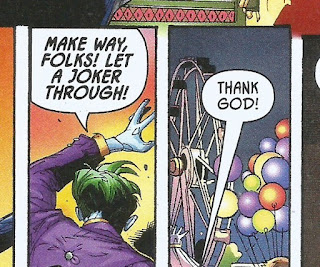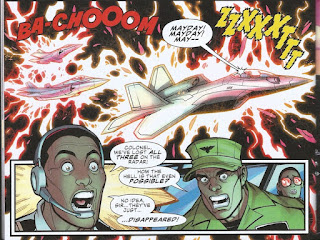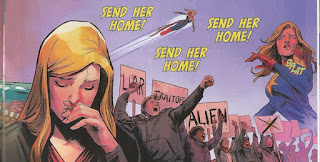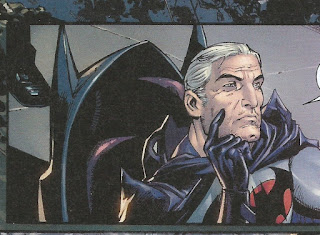Pick of the Brown Bag
July 17, 2019
by
Ray Tate
This week the Pick of the Brown Bag reviews Aquaman, Batman, Captain Marvel, Doctor Who, James Bond, Unstoppable Wasp, Vampirella and Wonder Woman: Come Back to Me. As always should the hustle and bustle of the real world preclude deep reading, check me out on Twitter: #PickoftheBrownBag.
Get ready for Jody Houser’s best Doctor Who story to date. Seriously, it’s so good that I wish it had been filmed for the series.
Spoilers can be found at the bottom of the blog.
The Doctor planned a peaceful outing with her friends Yaz, Ryan and Graham. The local constabulary interrupts her respite by disclosing a crime perpetrated by a twin-hearted female criminal.
The Doctor escapes, because she's the Doctor. She thinks her old frienemy the Master/Missy is responsible. She tracks down the thief. It turns out to be another alien from the series.
This story is about watching emotion pour out of two old adventurers.
Part of the fun comes from Ryan's, Yaz's and Graham's reactions. All however is not light. The Doctor holds a secret. A Fixed Point in time seals her friend's fate.
The absolutely brilliant and moving execution by artist Roberta Ingranata and cosmic-hued Tracy Bailey convey an atmosphere of bitter sweetness. If you don’t get a little lump in your throat afterward, you just may be a Cyberman.
Vampirella is an old character. Both in terms of fiction and history. She began life in 1968 in her own magazine published by Warren. When the magazine folded after issue 112, she resurfaced in Harris comics for a whopping forty or so issues before finding a permanent home at Dynamite. And this is only tallying her solo appearances.
The latest volume of Vampirella by Christopher Priest touches on her backstory. The tale opens on a plane crash with one survivor.
Priest uses the device of a government assigned therapist to spotlight Vampirella's origins and the narrative about the plane crash.
Priest's style and humor is evident throughout the book, and he delves deep into Vampirella's past to describe his narrative. A Vampirella villain caused the plane crash and in the process upset her life. Daktari continues to doubt Vampirella's story but when playing devil's advocate goes straight back to the science fiction original. I approve.
Vampirella is an alien from the planet Drakulon. Her people gave rise to the legends of vampires. Vampirella dedicates her life to fight for her adopted world and the people on it. The supernatural may in fact be the Cthulhu science of dread. A good start to a redefinition of Vampirella.
In the latest issue of Tom King’s Batman, Bane takes over Gotham City. King’s been building to this turn of event for several issues hence, and now literally the inmates are in charge of the Asylum. The story is even more bizarre than you think, and I can’t say much about it. Suffice to say not everybody’s on board, and the people who are will surprise you. More in the spoiler section.
Funny story. I was all set to drop Aquaman. It just no longer seemed like Aquaman. At first I gave Kelly Sue DeConnick a chance with amnesiac Aquaman. The story she told was interesting for a while. I genuinely liked her new character Cally.
Robson Rocha’s art was a great boon, but then DeConnick started to lose me with the Mother Shark thing. Her trip down memory lane and her explanation about how Aquaman died soured me. I also suspected ill of her regarding Queen Mera’s marriage.
I thought she would marry Mera off and we’d have some horrible melodramatic subplot involving Aquaman not being able to marry Mera, splitting up with her, reuniting, etc. So, this was the make or break issue of Aquaman. Surprisingly, Kelly Sue DeConnick made it.
DeConnick’s quick turnaround. Her decision to dive deep into Aquaman rather than her own characters made me reconsider.
At first Aquaman seems like more of the same. Why are we discussing this old, long-dead dude even if he's part of the origin of Aquaman's lighthouse? The teller of the tale turns out to be well known to Aquaman fans.
Now, this is an Aquaman book. Officer Erika Watson is Amnesty Bay.
Aquaman's return ignites a media storm. Reporters though aren't the only visitors to Aquaman's home on land.
DeConnick’s Wonder Woman is a treasure. DeConnick takes license to reinvent some of Wonder Woman’s recent mythology, to speak out against the Trump era.
Historically speaking DeConnick isn’t wrong about Wonder Woman’s implications regarding the Amazons. Certainly Patty Jenkins director of Wonder Woman embraced the gist of the original tale. This does more or less throw a wrench in Brian Azarello’s latter volumes of Wonder Woman. I’m good with that.
Tula, Aquaman’s half-sister and former regent of Atlantis, shows up during a hilarious running gag about Aquaman’s love for cereal. The cereal bit is a new thing, but as Supergirl asked her cousin once, “What do you think Aquaman eats? It can’t be fish. He’d hear them scream.”
DeConnick segues to the ocean depths where Mera makes her decision on who to marry. It’s a brilliant solution to the problem.
Mera and Aquaman belong together. As far as couples go, they're right up there with Superman and Lois Lane, bound together by their creators.
However, the preservation of Aquaman and Mera was more than just a fictional demand. Mera's move against the conservatives of the Atlantean Council is utter genius. It's the kind of guile I expect from a queen and tactician. If you backed Mera into a corner where she's forced to marry somebody unworthy in some sort of swashbuckling perversion, then you diminish her intellect and her political status as a progressive. This was satisfying.
Black Manta features prominently on Aquaman’s cover, but as with many of these Year of the Villain tie-ins, Black Manta doesn’t appear until the very end and he doesn’t interact with Aquaman or Mera. So, if you're expecting and wanting a huge Aquaman/Black Manta duel you will be disappointed.
The former Harley Quinn team of Jimmy Palmiotti, Amanda Conner and artist Chad Hardin put their personal stamp on Wonder Woman in the new maxi-series Come Back To Me.
The story begins with Steve Trevor and Wonder Woman basking on a beach near Wonder Woman’s home in Ocean City, Maryland.
Yes, they’re a couple in this story. And a cute one at that. The relationship is nothing new. It started in the Golden Age and ended in the Bronze only to be resuscitated in the New 52 and outside the lines tie-ins like Smallville. As well as the Wonder Woman movie. The cuteness though likely comes from the trio.
Steve’s headed toward an air base in the Caribbean to test an experimental flight device. It doesn’t matter what it is. It’s not even a McGuffin. This is all a set up to replicate Steve’s historical habit of getting lost on islands.
While Steve’s away Wonder Woman keeps herself occupied by rescuing a group of trapped firefighters in Montana. This is where things get extra special.
The creative team not only demonstrate Wonder Woman’s strength, and characterize her as a rescuer. They also remember one of the subtler of her gifts from the gods.
Being rescued by superhero isn’t all that it's cracked up to be it seems. When you explain what happened, nobody believes you, unless your savior happens to be a warrior with a taste for brew.
This is new territory, but it’s absolutely fitting. The Conner/Palmiotti and Hardin Wonder Woman is a meld of warrior woman, superhero and acclimatized stranger from a strange land.
In the second part of the book, Wonder Woman and Etta look for Steve.
The Invisible Jet actually has a longer life-span than the Wonder Woman/Steve relationship. It even made the cut in the television series. Seldom do writers say no Invisible Jet. It’s just one of those intrinsically cool things Wonder Woman myths brought to the table. Black Etta Candy is a New 52 entry. The Mo-Hawk is something fresh though.
Wonder Woman’s and Etta’s journey takes them smack into the same reality disturbance that swallowed Steve and his fly escorts. They do not end up in Paradise.
Yup. It’s a Land That Time Forgot kind of day, but thanks to Hardin’s art and Alex Sinclair's colors, the sight of Wonder Woman decking an aquatic dinosaur never gets old.
Captain Marvel begins a new story with Carol on the outs.
So, Kurt Busiek can be credited with turning Carol into an alcoholic. I’ve never been crazy about the change, but Kelly Thompson only uses it as an added stressor, demonstrating how far Carol fell.
Carol will always be an alcoholic. She's sober now, and like Sherlock Holmes on Elementary treasures that sobriety.
The story begins in the present but reels back to the past to find the pieces of the puzzle that made Carol buy a bottle. What appears to be an alien invasion leads to Carol suffering from an unknown malady.
Nosebleeds are the superhero equivalent of coughs in chick flicks. I have no idea how or why this became so popular. Seldom do nosebleeds in the superhero pack any factual basis. Unless of course a superhero is punched in the nose.
Thompson introduces a new hero with a familiar power set named Star. Does she connect to Carol’s physical problems?
A lucky shot and her newfound weakness sends Carol to La-La Land.
Fortunately, her best friend is on hand to back her up. Thompson amusingly takes this opportunity to display Jessica Drew’s wisecracking to mask concern and also to callback to she and Carol's first meeting.
I’d expect nothing less. As the story continues, Thompson uses a lot of continuity that she never created to kneecap Carol. Being drummed out of the air force for being a half-human for example.
The Kree mother idea came from a book I never read and dismissed outright. The idea of Carol having a Kree mom doesn’t make a helluva lot of sense given that we’ve met her human mother and witnessed her origin in her original title Ms. Marvel . Furthermore, the movie keeps Carol human, that was kind of the whole point.
Thompson incorporates a lot continuity I don’t care about in a smart way. She may not like this stuff either but saw it as means to redirect Captain Marvel into politics.
You may think that somebody at Marvel adjusted the book to serve notice to Donald Trump's racist assery but I doubt it. The thing is. Racists that don't think they're racists are always telling U.S. citizens to go back to their own countries. That includes fair-skinned Irish Catholics of the nineteenth century. Racists always believe they're smarter than everybody else and can sense when somebody's not from around here. They're not. They can't. Thompson just follows the dots of unfortunate history.
Unstoppable Wasp concludes the latest volume with old nemesis Monica Rappaccini heading AIM and a group of female mercenaries bent on taking over Nadia Van Dyne’s gender specific science group GIRL.
Rappaccini fought Nadia in volume one of Unstoppable Wasp. Nadia, the daughter of Hank and Maria Pym, teamed up with Bobbi Morse, who was a scientist before becoming, Mockingbird.
Nadia impressed Rappaccini enough to warrant watching.
Though Rappaccini is all about greed. Her group fly under a pretense that they are actually saving the world. Nadia hasn't been told the whole truth about her father.
Writer Jeremy Whitley employs some mostly forgotten continuity. I only know this because I read Guardians of the Galaxy. That book is no more. The Guardians and the Nova Corp dealt with the Ultron/Hank assimilation program. Of course maybe news of those events haven’t yet reached earth due to the time dilation.
In any case, Monica and her henchwenches with the “adorable beekeepers” from AIM attack GIRL’s first Expo. The surprise attack combined with industrial espionage gave them the advantage, but in this issue, Nadia and GIRL turn the tables on them. The book opens at the cliffhanger.
Fantasma is a kind of offline Troll who uses Nadia’s tech and his own distaff personality to carry out evil deeds. This one gets no sympathy.
Finesse on the other hand was an Avengers Academy graduate, and her apparent change of heart is due to the Hank/Ultron dichotomy. As well as kicks. Still, she made an enemy out of Ying when she attacked her girlfriend Shay.
Ying is Nadia’s bff and like Nadia a refugee from the Red Room, the same Russian discipline that helped create the Black Widow. According to retro fit Marvel continuity anyway. I’m not a fan of the Red Room, even if so created by a superior Black Widow writer, Richard K. Morgan.
As the battle ensues, the science goes Doctor Who with a live volcano threatening Manhattan and reordering Rappaccini’s personnel.
In addition Shay’s Portal tech suffers from sabotage and forces a sacrifice until Nadia engages one of her father’s powers.
It’s interesting that Pym did this because of an inferiority complex. Nadia demonstrates her mastery because she feels empowered and on a comprehensive level regarding her inherited bipolar disorder.
The conclusion to The Unstoppable Wasp is unabashedly upbeat, with GIRL gaining in ranks, Nadia embracing her maturity, Mockingbird and Bucky returning from Russia with news for Ying and Rappaccini stopped cold by a special guest star.
Greg Pak’s re-imagination of classic Ian Flaming novel and James Bond film Goldfinger may raw some purists, but this issue of James Bond actually works without any reference to Goldfinger.
M sent Bond on a mission to eliminate ORU, a terrorist organization. Bond works undercover, and as such, ORU implanted a conditioning device. Do good, and you get a hit of drug. Do bad, and…
His cohorts are John Lee and Amari, both South Korean agents. John is in this to get Amari out of it.
Moneypenny has orders to kill Bond should he prove to be unredeemable. Of course, Bond hasn’t gone to the other side. Instead, he’s using the mission to go above and beyond to free his colleagues and himself from the drug/taser dispenser.
How does he do that? The only way Bond, James Bond can. Brilliantly. Unexpectedly and with dramatic elegance.
S
P
O
I
L
E
R
S
E
C
T
I
O
N
The alien in question is the Doctor’s old friend The Corsair, mentioned in television story “The Doctor’s Wife.”
While the Matt Smith Doctor upon regenerating does think momentarily he’s a girl, Corsair is the first real proof of Time Lord gender-switching. The Doctor states that Corsair regenerated into women a few times. This is one of the comely incarnations.
A fallacy that’s grown in fandom is the idea that Time Lords immediately recognize each other through a kind of passive telepathy. The series contradicts this odd belief. The disguised Master hoodwinks the Doctor regardless of his incarnation. The fourth Doctor doesn’t recognize his Time Lord companion Romana when she regenerates. The Corsair doesn’t recognize the Doctor until she pulls out her signature.
When she does, her reaction is even lovelier than her initial response. When you read the comic book, note the distance, emphasized by the creative team, between the Doctor and Corsair. Corsair has the speed of a Muppet.
When the rabble get even more outraged by the Doctor’s interference, the Corsair melts your heart even more as she steps in front of her friend to protect her.
Similar to what the Master did in the final David Tennant episode “End of Time.”
As the story continues, the plot though enjoyable becomes meaningless as you just want to experience Corsair. Houser characterizes her with the Doctor’s trickery, probably a factor in their friendship.
She also demonstrates expert swordplay and is familiar with the Doctor’s admonishing lectures.
Roberta Ingranata and Tracy Bailey. Remember those names. Though not capricious, the Corsair doesn’t possess the Doctor’s deference to lifeforms.
Although, the Doctor does kill. Gender hasn’t changed that. The Doctor however is more of a sheriff killing in the line of duty. Corsair lives up to her name. She also demonstrates Time Lord arrogance, which the Doctor usually cannot tolerate.
So it turns out that the Corsair was actually trying to be more like the Doctor and steal for the sake of goodness. The Corsair in fact needs backup for a particular dicey heist, and this is where the book will make you possibly weep. As I said in the non-spoiler section of the blog, the Corsair’s fate is sealed by a Fixed Point in Time. The creative team remind you of this.
The Doctor simply wants to spend time with her friend who she knows will die. That is so sweet.
In the War of Jokes and Riddles the Joker is at lethal odds with the Riddler. That’s why its so strange to see them in a buddy cop movie at the beginning of Batman.
The animosity occurred long before Batman ever met Bane. This collusion is perhaps the strangest thing about Batman because it rankles even the internal consistency of Tom King’s saga. Bane though has a secret weapon that turns enemies into friends. That’s the key to making all of this madness possible.
Gotham’s “finest” investigates the murder of Double X, who figured prominently in one of King’s Batman team-ups. Their immediate conclusion indicates their high intellect. Not everybody is a Bane man, and King’s exclusions make perfect sense.
The Joker and Riddler report their findings to the Commissioner. Not Gordon, not Bane either. He raises the Bat Signal.
Not Batman. It turns out that the winner of the contest last issue for once wasn’t Batman.
But the ersatz Flashpoint Batman Thomas Wayne. Does this mean Bruce is dead? Alfred doesn’t believe it.
Neither of course do I. One thing I don’t understand is what Thomas Wayne gets out of this whole shindig. He claimed to be working to kill the concept of Batman. To be a family with his son Bruce, and in a seriously deranged way, Martha.
What pleasure does he get in being Batman if he’s working for Bane. I suspect that Bane influenced him when Thomas Wayne wasn’t looking. He turned Thomas from a man with a plan to a man with Bane’s plan.
And in Unstoppable Wasp guest-starring...
Love. In full bikini uniform, gorgeously illustrated by Gurihiru


































































